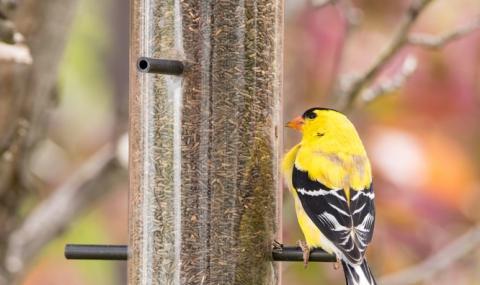
When my husband and I moved into our new home last month, the first thing we did was hang bird feeders from our deck. Birding is one of my favorite pastimes (bonus: it’s good for you,) and while getting out into nature and seeing birds on the trail is fun, there’s nothing like watching birds flock to your feeders as you nurse a mug of tea or sit down for dinner with the family. While a simple mixed birdseed and any old feeder can do the job, if you’re looking to attract a wide variety, or even a specific species, it pays to know your seeds and how to display them.
Attracting Specific Birds to Your Backyard
Woodpeckers
Woodpeckers are part of a large family of birds, but the most common ones to feeders include pileated, hairy, and downy woodpeckers, sapsuckers, and Northern flickers (both red and yellow shafted.) Although some woodpeckers can get crafty with typical feeders, using a suet feeder with a tail prop (simply an extended piece of wood where the birds rest their tail feathers as they feed) works best.
Woodpeckers are attracted to suet due to the high-fat food source. Made of ingredients like beef tallow, peanuts, corn, and various seeds, suet is a solid choice for woodpeckers and other birds, like chickadees and nuthatches. While suet is typically cheap, making your own can be more economical, and even healthier for the birds. Using ground peanuts as your base, add cornmeal, sunflower seeds, and even dried mealworms, forming it into a rectangle that fits the size of your suet feeder.
Chickadees
Despite their diminutive size, chickadees are often the bravest backyard birds, checking out the new feeder first. While mixed seed will work, black oil sunflower seeds are their preferred food source. Suet is another favorite; simply add sunflower seeds to a homemade mix.
Tube and platform feeders work well, but consider a squirrel guard if nearby squirrels are apt to steal most of the birdseed.
Nuthatches
Nuthatches are bold, quirky birds that are a similar size to nuthatches. Often seen creeping up trees, nuthatches are attracted to many of the same food sources that woodpeckers and chickadees like, so a selection of seed and suet works well.
Finches
Finches include purple finches, house finches, pine siskins and goldfinches (along with lesser and American goldfinches.) While these birds will eat mixed seed from tube feeders, specific finch feeders work best and are characterized by thin, mesh-like tubes. Nyjer (better known as thistle seed) is the best seed to attract these birds to your yard.
Hummingbirds
Hummingbirds don’t eat seeds, but instead sip nectar from flowers. To imitate this, many bird-lovers place red-dyed hummingbird feeders on back decks. This is a great way to attract these beautiful birds, but red dye can be harmful. Instead, use a mixture of dye-free sugar water (never honey, as it can mold) and add it to a hummingbird feeder. Bright colors are especially attractive, so planting a variety of flowers like dahlias, bee balm, and delphinium can help.
Orioles
Orioles are gregarious birds that are best characterized by their bright yellow-orange coloring. Oriole feeders can be purchased, but making your own is easy. A platform feeder with a variety of fruit, like oranges and melons, along with a selection of mealworms, can provide a happy feast.
How to Attract More Birds To Your Feeder
Attracting a wide variety of birds to your feeder is about more than just the food you’re putting out. Birds need shelter, and feel safer with trees, bushes, and other nesting sites nearby. Placing your feeders near tall deciduous or coniferous trees can help, along with planting native plants. Some birds are more likely to come to flowering plants (like hummingbirds,) while others prefer evergreens—where the leaves of the tree stay on year-round. Consider planting native bird food—the food sources that local birds would come to if feeders didn’t exist. To keep birds in your yard, try adding nesting boxes, small fountains or other clean water sources, and brush piles for shelter.
How do you attract birds to your yard? What species have you seen?








